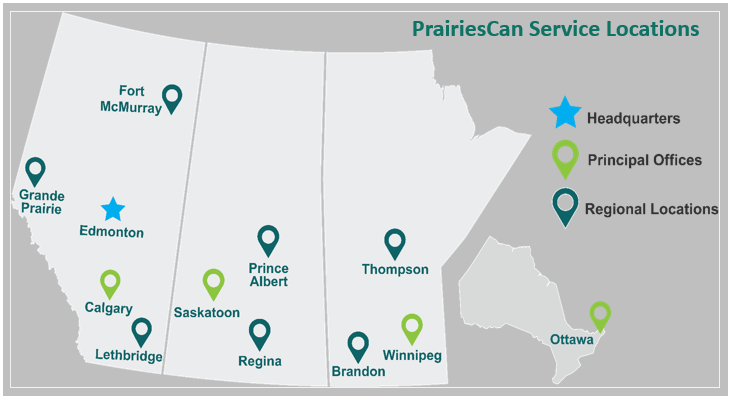4. – PrairiesCan at-a-glance placemat
Prairies Economic Development Canada
- ~333 Employees
- $362.2M* PrairiesCan 2024-25 budget
*Of this, $208.5M is for time-limited programs - Enabling legislation: Western Economic Diversification Act
Key PrairiesCan contact
Diane Gray, President
diane.gray@prairiescan.gc.ca
780-495-5772
PrairiesCan priorities
New value and competitiveness
- Accelerating economic growth through new sources of value & innovation in traditional sectors
Green economy
- Enabling success in a net-zero future
Inclusivity
- Fostering a more equitable & inclusive economy
PrairiesCan goals
- Businesses are growing across the Prairies
- Communities are developing economically in the Prairies
- Prairie businesses are commercializing and adopting technology
Past PrairiesCan results
Since its creation in 2021, PrairiesCan has directly invested $1.1 billion in over:
- 340 communities
- 380 SMEs
- 850 not-for-profits
These investments have supported over 170,000 jobs across the Prairies.
PrairiesCan service locations

Text description: PrairiesCan service locations
City |
Type of office |
|---|---|
Edmonton, Alberta |
Headquarters |
Calgary, Alberta |
Principal office |
Saskatoon, Saskatchewan |
Principal office |
Winnipeg, Manitoba |
Principal office |
Ottawa, Ontario |
Principal office |
Fort McMurray, Alberta |
Regional location |
Grande Prairie, Alberta |
Regional location |
Lethbridge, Alberta |
Regional location |
Prince Albert, Saskatchewan |
Regional location |
Regina, Saskatchewan |
Regional location |
Brandon, Manitoba |
Regional location |
Thompson, Manitoba |
Regional location |
The Prairie region
- 18% of Canada’s population
- 23% of Canada’s nominal GDP
- 28% of Canada’s total capital expenditures
- 35% of Canada’s international goods exports
The top 5 sectors on the Prairies include:
- Mining, quarrying, and oil and gas extraction (16.5%)
- Real estate and rental leasing (11.8%)
- Manufacturing (8.2%)
- Construction (7.7%)
- Health care and social assistance (7.1%)
Alberta
- Nominal GDP: $459B (2022)
- Population: 4.8M (Q2 2024)
- The highest economic output per capita in Canada.
- Oil and gas makes up a significant portion of the economy.
- Home to Canada’s largest wind generating facility and two largest solar facilities.
Saskatchewan
- Nominal GDP: $114B (2022)
- Population: 1.2M (Q2 2024)
- Account for the largest share of Canada’s total farm area.
- Home to critical minerals and rare earth elements that are rising in global demand.
- Key exports include wheat, potash, and uranium.
Manitoba
- Nominal GDP: $87B (2022)
- Population: 1.5M (Q2 2024)
- Steady growth in times of prosperity and minimal economic decline during recessions.
- One of the cleanest electricity grids in the world, with power generated from hydroelectricity.
- Diversity of exports including medicaments, wheat, seed oils, pork, and canola seeds.
Key Prairie economic and environmental challenges
- Capital expenditures down 29% from 2014 high ($126 billion) due to oil and gas decline
- The Prairies are leading in labour productivity, but it is concentrated in few industries and is declining
- Prairie greenhouse gas emissions are now larger than the rest of Canada combined
- Natural disasters such as wildfires and drought are becoming a common occurrence
Permanent Grants and Contributions programming
Businesses receive zero-interest repayable funding. Not-for-profits receive non-repayable funding.
Regional Economic Growth through Innovation (REGI)
- Business Scale-up and Productivity: support for high-growth businesses to scale-up
- Regional Innovation Ecosystem: funding for not-for-profit organizations to support entrepreneurship
Community Economic Development and Diversification (CEDD)
- Support for economic growth and diversification of communities
Economic Development Initiative (EDI)
- Support economic development projects in Official Language Minority Communities
Prairie Business Services Network (PBSN)
- Support for external organizations that help entrepreneurs start or expand small businesses, including rural areas and underrepresented groups
Temporary Grants and Contributions programming
Regional Artificial Intelligence Initiative
- Investment to help drive AI adoption by SMEs and sectors across the country (active until 2029)
Regional Homebuilding Innovation Initiative
- Support to advance new homebuilding methods and boost productivity (active until 2026)
Prairie Performing Arts Initiative
- Support for performing arts organizations based in the Prairies (active until 2027)
Black Entrepreneurship Strategy
- Supports Black business owners and entrepreneurs (active until 2025)
Canada Coal Transition Infrastructure Fund
- Helps communities impacted by transition away from coal (active until 2026)
Regional Quantum Initiative
- Deliver funds in support of the ISED-led National Quantum Strategy (active until 2029)